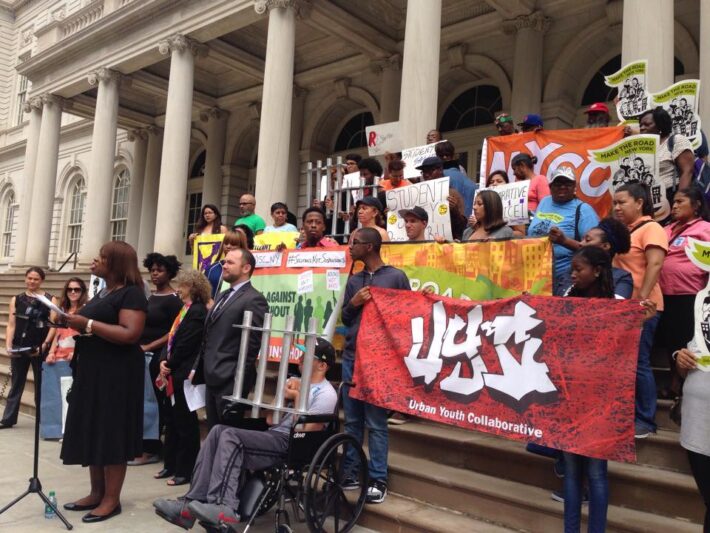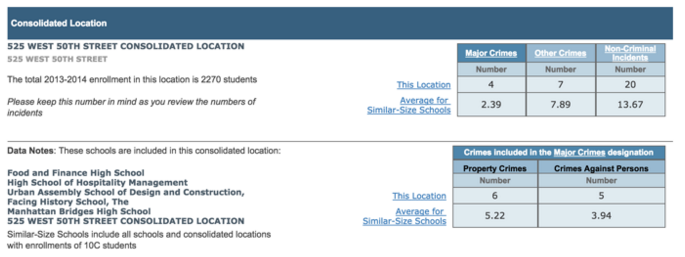
A local law expanding on the School Safety Act will require the New York Police Department and Department of Education to be more forthcoming in reporting about safety and disciplinary practices in the city’s public schools.
The amendments are the latest in a spate of initiatives meant to curb school disciplinary policies that critics call punitive – including the presence of metal detectors in schools and the use of handcuffs on students. Passed by the City Council on Sep. 30, the reforms demand that the NYPD and DOE provide additional data about school safety practices, which will supplement reports already mandated by the 2011 School Safety Act. New York City Mayor Bill de Blasio signed the bill on Oct. 13, and the reforms will take effect starting Jan. 1, 2016.
“The safety of our students is extremely important but so is the climate in which our students learn,” said council member Vanessa Gibson (D-Bronx), who sponsored the legislation, at a press conference the day before the vote. “Suspensions and zero tolerance policies have been proven to adversely impact our most vulnerable students and ultimately do not lead to positive behavioral changes or academic success.”
Several schools in Midtown West have metal detectors in place, including the Park West campus on West 50th St. The campus houses five smaller high schools on grounds previously inhabited by Park West High School, which reported several incidents of violence before graduating its last class in 2006. Administrators of the five Park West campus high schools either could not be reached or said they were unable to comment, but a 2014 DOE report shows that, at all five of the schools, the percentage of students who “feel safe in the hallways, bathrooms, locker rooms, and cafeteria” is higher than the city average.

“I don’t have a problem with the metal detectors,” said Christopher Alfred, a senior at The Facing History School, one of the schools on the Park West campus. “I feel safer,” he said, although he added that it is “annoying to take everything out” to go through them.
Annette Arnold-Wilson, whose daughter attends a nearby middle school with security guards but without metal detectors, said she has confidence in her daughter’s school and administration, and would be open to safety measures like metal detectors if the school felt it was necessary. “I am certainly not an advocate for safety at any cost, and I do believe there are ways to be safe and diligent while still maintaining our personal rights and freedom,” she said.
WNYC and the NYCLU have pegged the number of New York City students who pass through metal detectors each day to be over 90,000, with at least 88 schools in the city equipped with permanent metal detectors.
Most metal detectors sprang up in schools under the tough-on-crime policy stance of the 1980s – “a time when Broken Windows theory was highly emphasized,” said Sally Lee, the Executive Director of Teachers Unite, an organization of New York City public school educators that’s a member of the Dignity in Schools campaign and the Student Safety Coalition.
The number of metal detectors in schools increased in the ’90s, against a backdrop of prominent school shootings, according to a 2013 policy brief from the Vera Institute of Justice, and the NYPD was given oversight of school safety in 1998. Several of the city’s most violent high schools were shuttered under former Mayor Michael Bloomberg’s administration, but the metal detectors lingered and, in 2006, the then-mayor implemented a new “roving” metal detector program.
Dawn Yuster, the director of the School Justice Project at Advocates for Children of New York, says there’s no clear protocol on how a school can get rid of their metal detectors – nor is there official data on which schools the metal detectors are in.
Statistics from WNYC note that 48 percent of black high school students and 38 percent of hispanic students attend schools with metal detectors, higher than the citywide average of 33 percent. At the Sep. 29 press conference, the bill’s co-sponsor, council member Corey Johnson (D-Manhattan), noted that African American, Latino, LGBT and special education students are the disproportionate recipients of discipline in schools.
Some students “feel like they’re being criminalized and jailed instead of being in a place of learning,” said Yuster. It can be traumatic for some students to interact with NYPD officers on a daily basis, and the metal detectors can become a flashpoint for conflict between them and officers, she said.
“I think the presence of metal detectors might set the tone to fear it,” said Ernest Modarelli, a member of Community Board 4 who works at a school without metal detectors.
Speaking at an April City Council meeting about the local law, the commanding officer of NYPD’s School Safety Division, Assistant Chief Brian Conroy, noted that the training for school safety agent recruits has increased from 15 weeks to 17 weeks, with the added two weeks dedicated to “training on how to better work with school administration and students in areas of collaborative problem solving,” he said. He added that the School Safety Division is working to “further enhance the positive role that our police officers and school safety agents have in creating the safe and productive learning environment.”
Crime, suspensions and arrests in New York City public schools have all declined in recent years, though Conroy stated that school safety agents recovered 1036 weapons and “dangerous instruments” – including nine firearms – on school grounds from the beginning of the 2014 school year until April 5, 2015.
“It is essential that students feel both safe and supported in school,” said New York City DOE deputy press secretary Jason Fink in a statement. “We have enacted critical reforms to improve school climate, training staff in restorative approaches and de-escalation, changing the protocols for calling 911, reducing suspensions and many other measures aimed at reducing conflict.”
